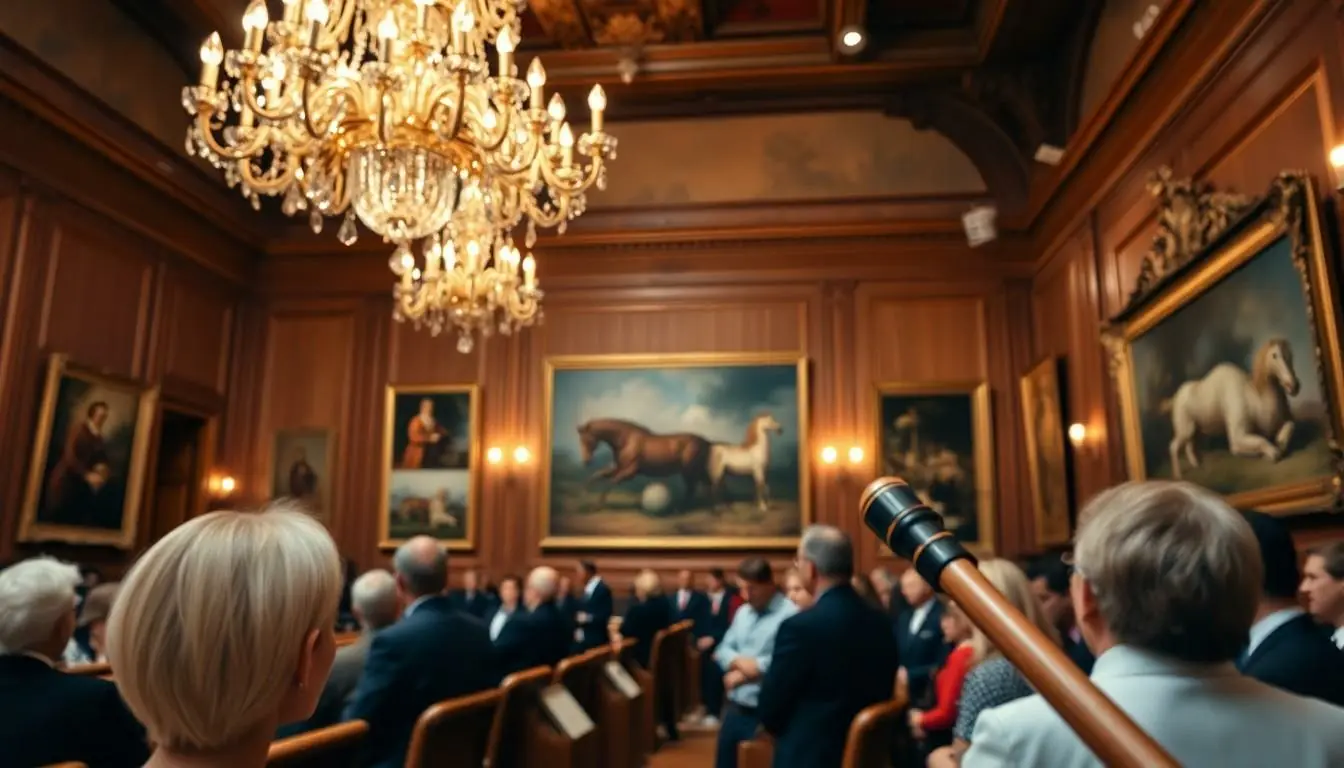In the world of art, antiques, and rare collectibles, auction houses reign supreme. They’re the glamorous arenas where fortunes are made and dreams are bid away. Imagine a packed room, the air thick with anticipation, as a gavel slams down on a long-lost masterpiece—it’s like a high-stakes poker game, but with a lot more glitter and a lot less bluffing.
Table of Contents
ToggleOverview of Auction Houses
Auction houses play a critical role in the sale and acquisition of valuable assets, including art, antiques, and collectibles. Renowned establishments like Sotheby’s and Christie’s dominate the landscape, hosting high-profile auctions that attract global bidders. Established in 1744, Sotheby’s remains one of the oldest auction houses, known for its diverse range of offerings from fine art to luxury goods. Christie’s, founded in 1766, stands out with its reputation for significant sales that often captivate the public’s attention.
Rare items fetch extraordinary prices at these auctions. For instance, a painting by Leonardo da Vinci sold for $450 million at a Christie’s auction in 2017. Results at auction houses often reflect current market trends, influencing buyers and sellers alike. Competitive bidding creates thrilling environments, where participants rapidly raise paddles, driving up prices in real-time.
Smaller auction houses also contribute significantly to the market, catering to niche interests. Regional auction houses showcase local artists and antiques, allowing collectors access to unique finds. Online platforms have expanded participation by eliminating geographical constraints, enabling bidders worldwide to engage remotely.
Moreover, auction houses implement strategic marketing techniques, targeting potential buyers through exclusive previews and curated catalogs. They leverage social media to enhance visibility and attract new clients. Technology continues to influence how auctions operate, with live streaming options allowing enthusiasts to participate from anywhere.
Auction houses contribute to cultural heritage preservation by connecting sellers with passionate collectors. Art institutions often collaborate with these houses to maintain the authenticity of objects sold. Overall, auction houses are vital in the evolving landscape of art and collectibles, merging tradition with modernity to shape future trends.
The Biggest Auction Houses in the World

Auction houses play a pivotal role in the sale of art, antiques, and rare collectibles. Among them, Sotheby’s and Christie’s stand out as the largest and most prestigious.
Sotheby’s
Sotheby’s, established in 1744, operates globally with auction locations in major cities. Renowned for its diverse offerings, this auction house features fine art, jewelry, and rare books. It regularly hosts high-profile auctions that draw international bidders. Noteworthy sales, such as the $450 million Leonardo da Vinci painting in 2017, demonstrate its market influence. Sotheby’s also leverages modern technology, providing online bidding options that expand participation. Exclusive previews and tailored marketing techniques generate significant interest. This combination of tradition and innovation solidifies its status as a leader in the auction world.
Christie’s
Founded in 1766, Christie’s ranks as a leading auction house with a strong global presence. It’s celebrated for its impressive sales of fine art, antiques, and design items. High-profile auctions often feature iconic works, attracting notable collectors and bidders. In 2019, Christie’s sold a Salvator Mundi attributed to Leonardo da Vinci for $450 million, highlighting its success. The auction house embraces digital advancements to enhance the bidding experience, offering live-streamed auctions and online catalogs. Its strategic marketing efforts, including targeted social media campaigns, cultivate a diverse audience. Christie’s commitment to quality and innovation maintains its prominent reputation in the market.
Emerging Auction Houses
Emerging auction houses play a crucial role in diversifying the market and expanding the reach of collectibles. They cater to specific niches, often providing fresh perspectives on art and objects.
Phillips
Phillips specializes in modern and contemporary art, with a strong emphasis on photography and design. Founded in 1796, it has developed a reputation for its innovative approach to auctions. The auction house often hosts themed sales that attract a younger demographic, appealing to new collectors. For instance, Phillips’ recent auction in 2021 featured works by contemporary artists, fetching impressive prices. Additionally, the integration of digital tools allows for seamless remote participation, broadening accessibility for bidders worldwide.
Bonhams
Bonhams focuses on fine art, the wine market, and luxury collectibles. Established in 1793, it ranks among the largest auction houses globally. Bonhams often emphasizes rare and unique items, such as classic cars and historic memorabilia. Noteworthy sales in recent years include a 1937 Talbot-Lago for over $13 million. The auction house effectively utilizes online platforms to engage bidders, ensuring they reach a global audience. By emphasizing authenticity and expertise, Bonhams enhances its position within the competitive auction landscape.
Impact of Technology on Auction Houses
Technology profoundly influences auction houses, reshaping the auction experience. Implementing online bidding platforms has expanded bidder access globally, allowing participation from diverse geographic regions. Real-time bidding apps enable bidders to engage instantaneously, heightening competition and driving prices upward.
Live-streamed auctions create excitement, attracting larger audiences as individuals tune in from their homes or mobile devices. Social media campaigns enhance visibility, drawing attention to high-profile sales and unique items. Auction houses effectively utilize targeted digital marketing strategies to reach younger demographics, captivating a new generation of collectors.
Data analytics play a pivotal role, allowing auction houses to track trends and preferences. Understanding buyer behavior helps refine marketing techniques and identify potential auction items. For instance, smaller auction houses leverage technology to cater to niche markets, showcasing local talent and rare antiques.
Virtual reality tools also emerge as valuable resources, offering immersive experiences that let potential buyers view items in detail. Enhanced imagery and video content contribute to creating a compelling auction listing. Innovation in payment processing simplifies transactions, ensuring secure and swift exchanges between buyers and sellers.
Sotheby’s and Christie’s exemplify market leaders adapting to technological changes, continually enhancing their auction processes. They invest in sophisticated online platforms, ensuring seamless bidder experiences. Emerging auction houses like Phillips and Bonhams follow suit, embracing digital tools to maintain relevance in a competitive landscape.
Collaboration with tech firms drives innovation further, leading to features that enrich the auction experience. Personalized notifications keep interested bidders informed about upcoming sales and relevant items. In a rapidly evolving market, technology fundamentally transforms how auction houses operate, emphasizing urgency and accessibility while maintaining their rich heritage.
The world of auction houses is a dynamic blend of tradition and innovation. They serve as vital platforms for connecting sellers with passionate collectors while preserving cultural heritage. With industry giants like Sotheby’s and Christie’s leading the way alongside emerging players like Phillips and Bonhams, the landscape continues to evolve.
Technological advancements have transformed the auction experience, making it more accessible and engaging for a global audience. As auction houses adapt to these changes, they remain essential in shaping the future of art and collectibles. The excitement of bidding and the thrill of securing a coveted item will continue to captivate enthusiasts for years to come.





